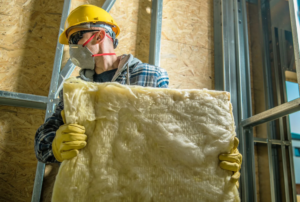Removing old insulation allows for the proper installation of new insulation, maximizing efficiency and comfort. It also minimizes the trapping of moisture, preventing the spread of mold and mildew.
Perth Insulation Removal is a demanding project that requires strict safety protocols and proper equipment. Personal protective equipment like a respirator, goggles, gloves, and coveralls prevent exposure to harmful particles.

When performing insulation removal, the safety of the individual carrying out the task should be the foremost consideration. Whether a homeowner is undertaking this project themselves or hiring a professional contractor, the proper preparation and execution of the process will ensure that no injuries or health risks arise during or after the procedure. The most effective way to protect against these risks is by utilizing the proper personal protective equipment. This includes rubber-coated gloves to guard against potential irritants, a mask that is N95-rated or higher, and eye protection. In addition to these items, disposable coveralls should be worn to prevent the transfer of contaminants to the person’s regular clothing or skin.
The first step in insulation removal is to thoroughly assess the situation. This will help the homeowner determine what type of insulation is present, as well as identify any existing issues like pest infestation or mold growth that may require special handling. The attic space should also be cleared of any stored items to facilitate the process and minimize potential damage to items.
If the existing insulation is contaminated with pests or is exhibiting signs of water damage, it might be necessary to perform a complete teardown. This process requires clearing the workspace of any obstacles and removing drywall to gain access to the old insulation materials. This will require the assistance of professionals and might entail a lengthy cleanup and disposal process.
When removing blown-in insulation, it is important to work slowly and carefully to avoid contaminating the living space with airborne particles. It is recommended that the homeowner use a vacuum equipped with a specialized attachment to remove as much loose insulation as possible. If this isn’t possible, the homeowner should wear a mask to prevent inhalation of dust and debris particles, as well as disposable gloves and goggles.
If the homeowner is working on an older home, they should consider having the area tested for asbestos before attempting to remove or replace the insulation. This will help to ensure the safety of the individual and avoid any costly damages or health concerns that could arise as a result of improper removal or disposal of asbestos.
Preparation
Insulation is a vital part of your home, increasing comfort and energy efficiency. However, it is common for insulation to need removal due to damage or age. Whether you’re replacing old insulation or renovating your home, it’s important to know the proper steps to take to ensure a safe and effective job.
The first step in insulation removal is to prepare the area. It’s essential to clear out any existing furniture or boxes from the attic space and seal off the workspace from the rest of the house to avoid contamination and limit the spread of dust and insulation fibers. Additionally, it is important to wear protective gear when working with insulation. This includes gloves, goggles, a respirator, and disposable coveralls to protect against dust and other airborne contaminants.
Once the attic space is cleared, it’s important to conduct a thorough inspection of the existing insulation. This will help identify any issues that need to be addressed, such as water damage or pest infestations. It’s also a good idea to inspect the joists and beams to make sure they are structurally sound.
Next, you’ll need to determine what type of insulation you have and decide on a plan for removal. Blown in insulation, or loose-fill insulation, is a popular choice for many homeowners. It’s usually made from cellulose or fiberglass and is often found in walls, attics, and crawl spaces.
For wall insulation, a stud finder may be needed to identify the location of joists and minimize any potential damage during removal. A utility knife and a long-handled vacuum are also necessary tools for removing insulation from the wall. Foam board insulation is typically a more rigid material and requires cutting tools for removal.
Once the insulation is removed, it’s important to dispose of it properly. This will help prevent environmental hazards and avoid any legal consequences. It’s best to consult with a professional insulation removal service to handle this process, as they will have the proper equipment and knowledge to safely recycle or dispose of the insulation. They will also follow local regulations to guarantee a smooth and effective process.
Removal
Removing old insulation is an important step to restoring the health, safety, indoor air quality, and energy efficiency of your home. Proper removal allows new insulation to properly do its job, resulting in consistent temperatures and lower utility bills. It also eliminates lingering odors and improves air quality in your home. Insulation that has been damaged by water, mold, or rodents requires prompt removal to prevent further damage and ensure structural integrity.
Different types of insulation require varying methods for effective removal. Proper identification of your insulation type and thorough preparation will simplify the process and lead to more efficient results. Whether you’re dealing with fiberglass batting, foam board, or cellulose, proper preparation will reduce the time and cost of the project.
Depending on the conditions and type of insulation, it may be necessary to seal off the work area or use a containment system during insulation removal. This is especially important when working with potential hazardous materials, such as asbestos and older fiberglass insulation. These materials can cause skin irritation and respiratory problems if handled improperly.
Before removing any insulation, it’s imperative to shut off and disconnect any live wires in the attic space. This will prevent electrical hazards and minimize the risk of fires or injuries during the removal process. It’s also a good idea to wear protective gear, including gloves, goggles, and a respirator mask. Additionally, a vacuum that’s specifically designed for insulation removal will minimize the amount of dust and debris that is created during the removal process.
The final steps in insulation removal involve cleaning and decontaminating the work area and preparing for disposal. This includes cleaning any remaining particles or fibers from surfaces and using a high-efficiency particulate air (HEPA) filter vacuum to reduce the spread of potentially harmful contaminants. If needed, professionals can also conduct a final inspection of the work area to make sure that all potential hazards and issues have been addressed.
Professional services are also well-versed in local regulations regarding the disposal of old insulation materials. This helps ensure that the work is done in compliance with environmental regulations, saving homeowners from potential legal consequences.
Disposal
Insulation removal requires careful planning and execution. It involves identifying the type of insulation, its condition, and any potential hazards, such as mold or pests, that may be present. It also includes establishing a clear workspace and removing any obstructions that may interfere with the insulation removal process. Finally, it includes implementing proper disposal methods and adhering to strict safety protocols. Insulation removal is a labor-intensive task that can be difficult for property owners to tackle on their own, especially if they don’t have the right equipment and knowledge. Hiring professional services can help ensure that the job is done efficiently, safely, and properly.
Choosing the right contractor to handle the project is essential. Licensed professionals have the skills and experience to perform a thorough inspection and identify any possible hazards before beginning work. They can also use specialized equipment to quickly and efficiently remove old insulation. They follow strict safety protocols when handling hazardous materials, including asbestos. Additionally, they are familiar with local disposal regulations and can make sure that the disposed materials are handled properly to protect the health of the homeowner.
When deciding on an insulation removal company, it is important to find one that has a good reputation and is reputable with past clients. Look for online reviews and ratings and request references before hiring a company. It’s also a good idea to research the company to ensure they are licensed and insured. This will protect the homeowner from a potentially dangerous project and avoid legal complications.
It’s best to begin the removal process at the farthest corner of the attic and work your way back towards the entrance. This helps to prevent tracking debris through areas that have already been cleaned and reduces the risk of contamination. Once the job is complete, it’s a good idea to sweep and mop the work area to ensure it is thoroughly clean. Finally, it’s a good idea to store any unused insulation in a sealed bag until it is disposed of. This will prevent the insulation from absorbing moisture, which can increase its weight and cause it to disintegrate more quickly.








